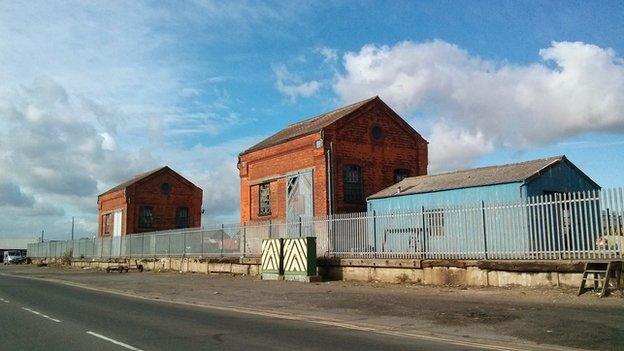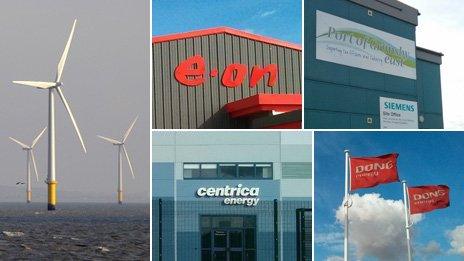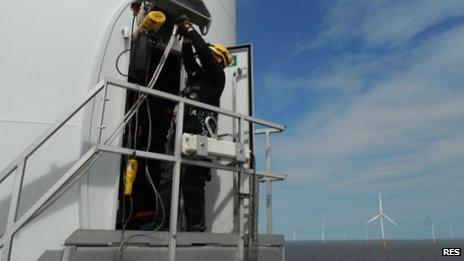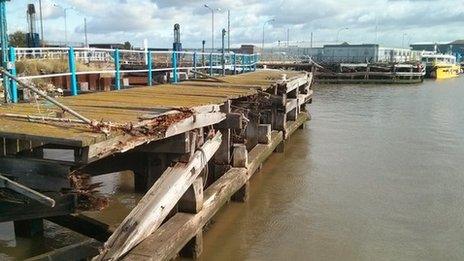Grimsby: Harnessing the power of renewable energy
- Published

Grimsby was once a thriving town with one of the busiest fishing ports in the world until it went into decline in the 1970s, and it now has one of the highest rates of unemployment in the country. But can the offshore wind farm industry turn its fortunes around?
At first glance the docks give the impression that all activity ended with the Icelandic Cod Wars and the collapse of the fishing industry. There are derelict and boarded-up buildings, empty streets and fish merchant signs peeling off the walls.
But look a bit closer and you will spot several brand new buildings, and some very snazzy looking boats.

Centrica and E.On are among the firms building and servicing wind farms
"This is not a quiet sleepy port in decline," says Jason Longhurst, head of development at North East Lincolnshire Council.
"It's a very busy port with the potential for much more."
The same qualities which led Grimsby to become a successful fishing port hundreds of years ago are what now makes it an attractive location for renewable energy companies to service their wind farms from.
Or, as Chris Holden from RES Offshore puts it: "Grimsby is the place to be by default, it just happens to be in the right place."
From an office at the fish market, RES provides operations and maintenance support to a number of North Sea wind farms, and has its eye on the enormous farms which are still at the planning stage, such as Dogger Bank and Hornsea.
"RES looked at every inlet and base from the Norfolk coast right up to Bridlington and decided Grimsby - with its infrastructure, skills, people, port access, support from the council - would be the right place to construct the Lynn and Inner Dowsing wind farm from and then to run operations and maintenance," Mr Holden said.
"We've got a 180 megawatt (MW) power station here that nobody in Grimsby can see. The entrance to the factory is here at the docks but you can't see the factory itself until you drive to Skegness."

Lynn and Inner Dowsing wind farm is about 90 minutes from Grimsby by boat

Chris Holden (left) and Jason Longhurst say offshore wind is "vibrant and thriving" in Grimsby

Despite recent investment the docks are still showing signs of age
The local council is not taking its fortunate location for granted though.
"The local authority took a decision two or three years ago that our role in renewable energy would be supporting the operations and maintenance market," Mr Longhurst says.
"We sat down with the sector and said 'what do you need?'"
What they needed were new, larger, lock gates so the vessels used by the wind farm companies could actually get into the dock. A £500,000 investment that could not be taken lightly at a time when the council was facing massive budget cuts.
But the new gates were built and Chris Shaw, Labour leader of North East Lincolnshire Council, says they brought with them Dong Energy, which is developing the 35-turbine Westermost Rough wind farm. It should be up and running in 2015, generating enough electricity for up to 210,000 homes.
"We're getting on to about 50 vessels now sailing out of Grimsby Dock East. That's fantastic, that's back to where the fishing fleet was," Mr Shaw says.
Dong Energy expects to create about 575 direct and indirect jobs in Grimsby over the next few years, and says its investment is worth about £800m to the town.
That is on top of an estimated 300 people who currently sail out of the docks every morning.
'Jobs needed'
But a few hundred jobs is a drop in the ocean in a district where 9,000 people are out of work, with an unemployment rate of 11.4%.
Speak to people in Grimsby town centre and you will not find much optimism.
Eddie Guyton, who runs a stall on Freeman Street Market, says the town will never return to its fishing heyday.
"Round here's been dead for the last 25 years, it's not doing anything now," he says.
"It's all right trying to create all these jobs but it's no good, it won't happen."
One of the town's many jobseekers, who did not want to be named, said: "Loads of people will go for those jobs. I'm old though, they'll be after apprentices in their 20s."
While Sue Shaw, who works in a shop at the docks, says: "If they bring jobs to the docks it's worth doing, but we do need a lot of jobs in this town."
And they have a point - there is no guarantee that the companies behind the huge wind farms planned for the future will pick Grimsby as their base.
Chris Shaw is undeterred.
"It's like every new industry, it hasn't had the effect yet on the town that it's going to have," he says.
"We've probably got another two years before we see some major job creation. We have to start somewhere."
And he says that gives them time to train people up for the jobs to come.
"The last thing we want is to suddenly get lots of jobs in the area and people will have to come from out of town to fill them."
The potential for "major job creation" could be well-founded. Energy Secretary Ed Davey has said the government's reforms to the electricity market will "help support up to 250,000 jobs in low carbon electricity generation by 2020".
Grimsby is staking its claim to those jobs. But so are its neighbours Hull and North Lincolnshire - both trying to finalise plans for wind turbine manufacturing plants.
Jason Longhurst says: "Long-term, I think North East Lincolnshire is probably sitting on the best piece of the cake with operations and maintenance.
"This isn't the icing of manufacturing some turbines, because you might get at most nine years out of that.
"Right now we are guaranteed 27 years of business."
- Published20 September 2013
- Published15 August 2013
- Published10 August 2013
- Published2 August 2013
- Published27 March 2013
- Published8 March 2013
- Published7 February 2013
- Published15 November 2012
- Published2 October 2012
- Published19 June 2012
- Published25 May 2012
- Published9 May 2012